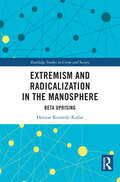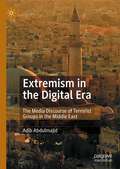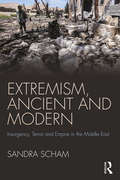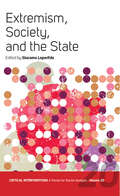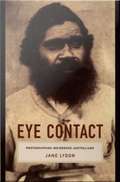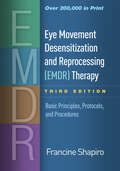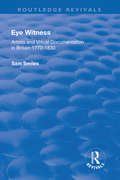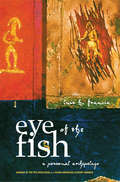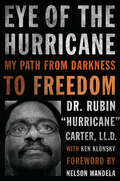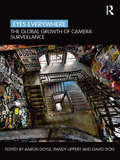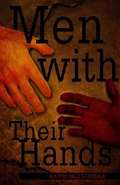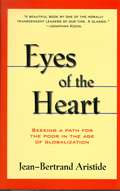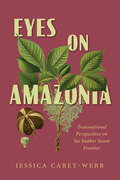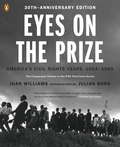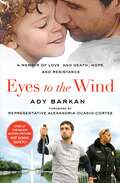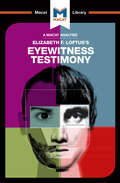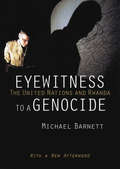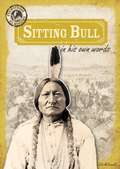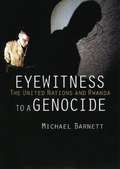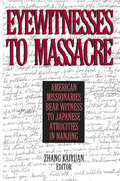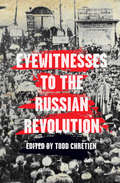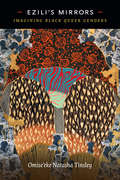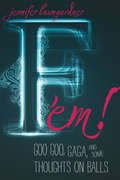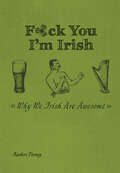- Table View
- List View
Extremism and Radicalization in the Manosphere: Beta Uprising (Routledge Studies in Crime and Society)
by Deniese Kennedy-KollarThis book presents an analysis of the male supremacist ideology of the internet-based subculture known as the manosphere and examines the process of radicalization to violent extremism that occurs within the group. The manosphere is the online subculture comprised of several distinct groups who share a basic gender ideology that is misogynistic and anti-feminist in the extreme. The manosphere celebrates a toxic hegemonic masculinity that encourages sexual violence and portrays violence as an understandable response to a feminized culture that denigrates manhood. Evidence has shown that several recent cases of murder, mass murder, and rape involved offenders who participated in this subculture prior to engaging in their crimes. Through the use of quotes gathered directly from the websites and message boards frequented by individuals within the subculture, this book offers an in-depth analysis of the ideology of the manosphere, and the common attitudes, values, and beliefs promoted within the various groups that comprise the subculture. It will also present a theoretical perspective that may shed light on what draws men to these groups and the processes by which they become radicalized to the far right and violent extremism. This book will be of interest to scholars and students in criminology, sociology, and political science, and others interested in examining the manifestation and effects of the manosphere on crime and criminal justice.
Extremism in the Digital Era: The Media Discourse of Terrorist Groups in the Middle East
by Adib AbdulmajidThis book constitutes a journey into the obscure field of sectarian-guided discourses of radical Islamist groups. It provides new insights into the ideological mechanisms utilized by such organizations to incite sectarian conflicts and recruit local and foreign guardians to their alleged cause. This book examines diverse aspects and dimensions of the discourses of Sunni-based ISIS and Shia-based al-Hashd al-Shaabi and explores manipulative and ideological discursive strategies utilized by media outlets associated with these groups. It delves into linguistic and contextual activities, implicit and explicit messages within the discourses of various media outlets operating in the heart of the Middle East. It also scrutinizes and explains aspects of politicization, religionization and sectarianization within the media discourse of terrorist groups in the digital era.
Extremism, Ancient and Modern: Insurgency, Terror and Empire in the Middle East
by Sandra SchamNear Eastern archaeology is generally represented as a succession of empires with little attention paid to the individuals, labelled as terrorists at the time, that brought them down. Their stories, when viewed against the backdrop of current violent extremism in the Middle East, can provide a unique long-term perspective. Extremism, Ancient and Modern brings long-forgotten pasts to bear on the narratives of radical groups today, recognizing the historical bases and specific cultural contexts for their highly charged ideologies. The author, with expertise in Middle Eastern archaeology and counter-terrorism work, provides a unique viewpoint on a relatively under-researched subject. This timely volume will interest a wide readership, from undergraduate and graduate students of archaeology, history and politics, to a general audience with an interest in the deep historical narratives of extremism and their impact on today’s political climate.
Extremism, Society, and the State: Crisis, Radicalization, and the Conundrum of the Center and the Extremes (Critical Interventions: A Forum for Social Analysis #20)
by Giacomo LoperfidoExtremism does not happen in a vacuum. Rather, extremism is a relative concept that often emerges in crisis situations, taking shape within the tense and contradictory relations that tie marginal spaces, state orders, and mainstream culture. This collected volume brings together leading anthropologists and cultural analysts to offer a concise look at the narratives, symbolic, and metaphoric fields related to extremism, systematizing an approach to extremism, and placing these ideologies into historical, political, and geo-systemic contexts.
Eye Contact: Photographing Indigenous Australians
by Jane LydonAn indigenous reservation in the colony of Victoria, Australia, the Coranderrk Aboriginal Station was a major site of cross-cultural contact the mid-nineteenth century and early twentieth. Coranderrk was located just outside Melbourne, and from its opening in the 1860s the colonial government commissioned many photographs of its Aboriginal residents. The photographs taken at Coranderrk Station circulated across the western world; they were mounted in exhibition displays and classified among other ethnographic "data" within museum collections. The immense Coranderrk photographic archive is the subject of this detailed, richly illustrated examination of the role of visual imagery in the colonial project. Offering close readings of the photographs in the context of Australian history and nineteenth- and early-twentieth-century photographic practice, Jane Lydon reveals how western society came to understand Aboriginal people through these images. At the same time, she demonstrates that the photos were not solely a tool of colonial exploitation. The residents of Coranderrk had a sophisticated understanding of how they were portrayed, and they became adept at manipulating their representations. Lydon shows how the photographic portrayals of the Aboriginal residents of Coranderrk changed over time, reflecting various ideas of the colonial mission--from humanitarianism to control to assimilation. In the early twentieth century, the images were used on stereotypical postcards circulated among the white population, showing what appeared to be compliant, transformed Aboriginal subjects. The station closed in 1924 and disappeared from public view until it was rediscovered by scholars years later. Aboriginal Australians purchased the station in 1998, and, as Lydon describes, today they are using the Coranderrk photographic archive in new ways, to identify family members and tell stories of their own.
Eye Movement Desensitization and Reprocessing (EMDR) Therapy, Third Edition: Basic Principles, Protocols, and Procedures
by Francine ShapiroThe authoritative presentation of Eye Movement Desensitization and Reprocessing (EMDR) therapy, this groundbreaking book--now revised and expanded--has enhanced the clinical repertoires of more than 100,000 readers and has been translated into 10 languages. Originally developed for treatment of posttraumatic stress disorder (PTSD), this evidence-based approach is now also used to treat adults and children with complex trauma, anxiety disorders, depression, addictive behavior problems, and other clinical problems. EMDR originator Francine Shapiro reviews the therapy's theoretical and empirical underpinnings, details the eight phases of treatment, and provides training materials and resources. Vivid vignettes, transcripts, and reproducible forms are included. Purchasers get access to a Web page where they can download and print the reproducible materials in a convenient 8 1/2" x 11" size. New to This Edition *Over 15 years of important advances in therapy and research, including findings from clinical and neurophysiological studies. *New and revised protocols and procedures. *Discusses additional applications, including the treatment of complex trauma, addictions, pain, depression, and moral injury, as well as post-disaster response. *Appendices with session transcripts, clinical aids, and tools for assessing treatment integrity and outcomes. EMDR therapy is recognized as a best practice for the treatment of PTSD by the U.S. Departments of Veterans Affairs and Defense, the International Society for Traumatic Stress Studies, the World Health Organization, the U.K. National Institute for Health and Care Excellence (NICE), the Australian National Health and Medical Research Council, the Association of the Scientific Medical Societies in Germany, and other health care associations/institutes around the world.
Eye Witness (Routledge Revivals)
by Sam SmilesThis title was first published in 2000: This study examines the ways in which very different visual fields might be said to have shared certain working assumptions concerning the truth of representation. It concentrates particularly on prints.
Eye of the Fish
by Luis H. FranciaThe first of Luis H. Francia's books of non-fiction to be published in the United States, The Eye of the Fish paints a vivid and detailed portrait of the terror, beauty and insistent humanity of the Philippines of today. <p><p> Cross-cutting between Francia's recollections of the Philippines of his youth and accounts of his travels through the archipelago over the past two decades, The Eye of the Fish takes us the length of the nation: from Batanes in the north to the Muslim Jolo and Marawi regions of the south, and from the rugged mountain hideaways of revolutionary freedom fighters to the well-appointed salons of the political and cultural elite. Painters and priests, island shamans and small-town politicians, cultists, feminists and infamous first ladies all make an appearance in this imaginative and idiosyncratic exploration of 'home.' <p> Through their stories, and through his own memories of estrangement and acceptance in the Philippines and in the U.S., Francia reflects on the hybridity that is simultaneously the burden and the benediction of the Philippines--and of his own mestizo self.
Eye of the Hurricane: My Path from Darkness to Freedom
by Nelson Mandela Ken Klonsky Rubin CarterA spiritual as well as a factual autobiography, this is a self-portrait of Rubin "Hurricane" Carter, a 20th-century icon and controversial victim of the U.S. justice system turned spokesperson for the wrongfully convicted. Exploring Carter's personal philosophy--born of the unimaginable duress of wrongful imprisonment and conceived through his defiance of the brutal institution of prison and a decade of solitary confinement--this work offers hope for those who have none and serves as a call to action for those who abhor injustice. Exposing the inherent flaws in the legal and penal systems, this autobiography also serves as a prison survival manual--be it a brick-and-mortar cell or the metaphorical prison of childhood abuse, racism, and despair.
Eyes Everywhere: The Global Growth of Camera Surveillance
by David Lyon Aaron Doyle Randy LippertIn many countries camera surveillance has become commonplace, and ordinary citizens and consumers are increasingly aware that they are under surveillance in everyday life. Camera surveillance is typically perceived as the archetype of contemporary surveillance technologies and processes. While there is sometimes fierce debate about their introduction, many others take the cameras for granted or even applaud their deployment. Yet what the presence of surveillance cameras actually achieves is still very much in question. International evidence shows that they have very little effect in deterring crime and in 'making people feel safer’, but they do serve to place certain groups under greater official scrutiny and to extend the reach of today’s ‘surveillance society’. Eyes Everywhere provides the first international perspective on the development of camera surveillance. It scrutinizes the quiet but massive expansion of camera surveillance around the world in recent years, focusing especially on Canada, the UK and the USA but also including less-debated but important contexts such as Brazil, China, Japan, Mexico, South Africa and Turkey. Containing both broad overviews and illuminating case-studies, including cameras in taxi-cabs and at mega-events such as the Olympics, the book offers a valuable oversight on the status of camera surveillance in the second decade of the twenty-first century. The book will be fascinating reading for students and scholars of camera surveillance as well as policy makers and practitioners from the police, chambers of commerce, private security firms and privacy- and data-protection agencies.
Eyes of Desire: A Deaf Gay & Lesbian Reader
by Raymond LuczakIn a collection of essays, deaf lesbians and gay men discuss their lives, describing how they discovered their sexual identity, overcame barriers to communication in a hearing world, and created a deaf gay and lesbian culture.
Eyes of the Heart: Seeking a Path for the Poor in the Age of Globalization
by Jean-Bertrand AristideIn this startling and passionate book, Aristide demonstrates why those on the bottom will never lie down. A graphic revelation of what happens when "free" trade overruns local markets, eradicates local economies, and creates dependence on foreign charity.
Eyes on Amazonia: Transnational Perspectives on the Rubber Boom Frontier
by Jessica Carey-WebbThe Amazon extends across nine countries, encompasses forty percent of South America, and hosts four European languages and more than three hundred Indigenous languages and cultures. Eyes on Amazonia is a fascinating exploration of how Latin American, European, and US intellectuals imagined and represented the Amazon region during the late nineteenth and early twentieth centuries. This multifaceted study, which draws on a range of literary and nonliterary texts and visual sources, examines the complex ways that race, gender, mobility, empire, modernity, and personal identity have indelibly shaped how the region was and is seen. In doing so, the book argues that representations of the Amazon as a region in need of the civilizing influence of colonialism and modernization served to legitimize and justify imperial control.Eyes on Amazonia operates in cultural geography, ecocriticism, and visual cultural analysis. The diverse and intriguing documents and images examined in this book capture the modernizing project of this region at a crucial juncture in its long history: the early twentieth-century rubber boom.
Eyes on the Prize: America's Civil Rights Years, 1954-1965
by Juan WilliamsThe 25th-anniversary edition of Juan Williams's celebrated account of the tumultuous early years of the civil rights movement From the Montgomery bus boycott to the Little Rock Nine to the Selma-Montgomery march, thousands of ordinary people who participated in the American civil rights movement; their stories are told in Eyes on the Prize. From leaders such as Martin Luther King, Jr. , to lesser-known figures such as Barbara Rose John and Jim Zwerg, each man and woman made the decision that somethinghad to be done to stop discrimination. These moving accounts and pictures of the first decade of the civil rights movement are a tribute to the people, black and white, who took part in the fight for justice and the struggle they endured. .
Eyes on the Prize: America's Civil Rights Years, 1954-1965
by Juan Williams Julian BondEyes on the Prize traces the movement from the landmark Brown v. the Board of Education case in 1954 to the march on Selma and the passage of the Voting Rights Act in 1965. This is a companion volume to the first part of the acclaimed PBS series.
Eyes to the Wind: A Memoir of Love and Death, Hope and Resistance
by Ady BarkanIn this inspirational and moving memoir—reminiscent of When Breath Becomes Air and The Bright Hour—activist Ady Barkan explores his life with ALS and how his diagnosis gave him a profound new understanding of his commitment to social justice for all. Ady Barkan loved taking afternoon runs on the California coast and holding his newborn son, Carl. But one day, he noticed a troubling weakness in his hand. At first, he brushed it off as carpal tunnel syndrome, but after a week of neurological exams and two MRIs, he learned the cause of the problem: amyotrophic lateral sclerosis, better known as ALS or Lou Gehrig’s disease. At age 32, Ady was given just three to four years to live. Yet despite the devastating diagnosis, he refused to let his remaining days go to waste. Eyes to the Wind is a rousing memoir featuring intertwining storylines about determination, perseverance, and how to live a life filled with purpose and intention. The first traces Ady’s battle with ALS: how he turned the initial shock and panic from his diagnosis into a renewed commitment to social justice—not despite his disability but because of it. The second, told in flashbacks, illustrates Ady’s journey from a goofy political nerd to a prominent figure in the enduring fight for equity and justice who is “willing to give [his] last breath to save our democracy” (CNN). From one of today’s most vocal advocates for social justice, Eyes to the Wind is an evocative and unforgettable memoir about activism, dedication, love, and hope.
Eyewitness Testimony
by William J JenkinsUnderstanding evidence is critical in a court of law – and it is just as important for critical thinking. Elizabeth Loftus, a pioneering psychologist, made a landmark contribution to both these areas in Eyewitness Testimony, a trail-blazing work that undermines much of the decision-making made by judges and juries by pointing out how flawed eyewitness testimony actually is. Reporting the results of an eye-opening series of experiments and trials, Loftus explores the ways in which – unbeknownst to the witnesses themselves – memory can be distorted and become highly unreliable. Much of Loftus’s work is based on expert use of the critical thinking skill of interpretation. Her work not only highlights multiple problems of definition with regard to courtroom testimony, but also focuses throughout on how best we can understand the meaning of the available evidence. Eyewitness Testimony is arguably the best place in the Macat library to begin any investigation of how to use and understand interpretation.
Eyewitness To A Genocide
by Michael BarnettWhy was the UN a bystander during the Rwandan genocide? Do its sins of omission leave it morally responsible for the hundreds of thousands of dead? Michael Barnett, who worked at the U. S. Mission to the United Nations from 1993 to 1994, covered Rwanda for much of the genocide. Based on his first-hand experiences, archival work, and interviews with many key participants, he reconstructs the history of the UN's involvement in Rwanda. In the weeks leading up to the genocide, the author documents, the UN was increasingly aware or had good reason to suspect that Rwanda was a site of crimes against humanity. Yet it failed to act. Barnett argues that its indifference was driven not by incompetence or cynicism but rather by reasoned choices cradled by moral considerations. Employing a novel approach to ethics in practice and in relationship to international organizations, Barnett offers an unsettling possibility: the UN culture recast the ethical commitments of well-intentioned individuals, arresting any duty to aid at the outset of the genocide. Barnett argues that the UN bears some moral responsibility for the genocide. Particularly disturbing is his observation that not only did the UN violate its moral responsibilities, but also that many in New York believed that they were "doing the right thing" as they did so. Barnett addresses the ways in which the Rwandan genocide raises a warning about this age of humanitarianism and concludes by asking whether it is possible to build moral institutions.
Eyewitness to History: Sitting Bull in His Own Words
by Julia McdonnellSitting Bull, the well-known Native American chief, united the Lakota Sioux in the northern Great Plains and led a mighty resistance of tribes who refused to be placed on reservations. This struggle resulted in violence, most famously at Little Bighorn in 1876. Though Sitting Bull fled to Canada, he ultimately returned to the United States in 1881. This book uses Sitting Bull's powerful words to examine the leader's considerable courage and determination as well as his aspirations for Native Americans.
Eyewitness to a Genocide: The United Nations and Rwanda
by Michael BarnettVery little about the Rwandan genocide is comprehensible. A Hutu elite came to believe that Hutu salvation necessitated Tutsi extermination. The Hutus enacted their conspiracy with startling efficiency. In one hundred days, between April 6 and July 19, 1994, they murdered roughly eight hundred thousand individuals. For the statistically inclined, that works out to 333&1/3 deaths per hour, 5&1/2 deaths per minute. The rate of murder was even greater during the first four weeks, when most of the deaths occurred. The Rwandan genocide, therefore, has the macabre distinction of exceeding the rate of killing attained during the Holocaust.
Eyewitnesses to Massacre: American Missionaries Bear Witness to Japanese Atrocities in Nanjing
by Zhang Kaiyuan Donald MacInnisThe infamous Nanjing Massacre of 1937, in which the Japanese Imperial Army raped and slaughtered countless Chinese citizens on the eve of World War II, has been described in well-publicized books from various Chinese, Japanese and German perspectives. But this collection of first-hand testimony from the archives of the Yale Divinit; School Library may be the most powerful record of all. Here are eyewitness accounts by a remarkable group of nine men and one woman - dedicated, compassionate, well-educated, articulate, and devout missionaries who were ther on the scene, refusing to leave, and doing everything in their power to save the Chinese victims of this appalling atrocity.
Eyewitnesses to the Russian Revolution
by Todd ChretienThis comprehensive chronicle of the Russian Revolution is told through the eyewitness accounts of journalists, political leaders, and ordinary citizens.More than a century ago, workers and peasants in Russia turned the world upside down when they overthrew their tsar, took over their factories, farms, and schools, and set out to build a new society. In this gripping reader, participants and firsthand observers of the revolution tell the inspiring, heroic, and sometimes tragic story of what happened in Russia over the course of 1917. Introduced and edited by Todd Chretien, Eyewitnesses to the Russian Revolution includes contributions from Leon Trotsky, Rosa Luxemburg, Vladimir Lenin, John Reed, Louise Bryant, and others.
Ezili’s Mirrors
by Omise'Eke Natasha TinsleyFrom the dagger mistress Ezili Je Wouj and the gender-bending mermaid Lasiren to the beautiful femme queen Ezili Freda, the Ezili pantheon of Vodoun spirits represents the divine forces of love, sexuality, prosperity, pleasure, maternity, creativity, and fertility. And just as Ezili appears in different guises and characters, so too does Omise’eke Natasha Tinsley in her voice- and genre-shifting, exploratory book Ezili's Mirrors. Drawing on her background as a literary critic as well as her quest to learn the lessons of her spiritual ancestors, Tinsley theorizes black Atlantic sexuality by tracing how contemporary queer Caribbean and African American writers and performers evoke Ezili. Tinsley shows how Ezili is manifest in the work and personal lives of singers Whitney Houston and Azealia Banks, novelists Nalo Hopkinson and Ana Lara, performers MilDred Gerestant and Sharon Bridgforth, and filmmakers Anne Lescot and Laurence Magloire—none of whom identify as Vodou practitioners. In so doing, Tinsley offers a model of queer black feminist theory that creates new possibilities for decolonizing queer studies.
F 'em!: Goo Goo, Gaga, and Some Thoughts on Balls
by Jennifer BaumgardnerFrom Jennifer Baumgardner, one of the leading voices of Third Wave feminism, comes this provocative, thoughtful, often funny collection of essays and interviews that offers a state of the union on contemporary feminist issues.F 'em! is a mix of old and new essays by Baumgardner, ranging in tone from laugh-out-loud confessional to sobering analysis. She investigates topics as varied as purity balls, sexuality, motherhood, and shared breastfeeding; rape, reproductive rights, and the future of feminism. The essays in F 'em! are rounded out by candid one-on-one interviews with leading feminists who have influenced Baumgardner's perspectives-including Riot Grrrls' Kathleen Hanna, Native American activist Winona LaDuke, transgender activist Julia Serano, and artists like Ani DiFranco, Björk, and Amy Ray. At turns intimate, fierce, philosophical, and funny, they are an intimate window into the minds and hearts of Third Wave pioneers. Holding it all together is Baumgardner's insightful thinking about what it means to be a feminist today, as she answers frequently-asked questions: What does it mean to be a woman today? Do we even need feminism anymore?Thought-provoking and cutting-edge, F 'em! provides a clearer and more complete understanding of feminism-its past, its present, and its future.
F*ck You, I'm Irish: Why We Irish Are Awesome
by Rashers TierneyAn in-your-face collection of trivia that’s sure to inspire chest-thumping pride in everyone of Irish descent.Is there anyone who does not think the Irish are the greatest people on Earth? Before stepping outside to convince them, first peacefully impart upon any misinformed bar patrons the incontrovertible evidence presented in F*ck You, I’m Irish. Amazing accomplishment or astounding person, if it bleeds kelly green and it’s feckin’ great, it’s in this book. Irish pride has sparked parades, breakfast cereal, beer, riots, international holidays, the fame of Liam Neeson, sports mascots, more beer, and now, this fun and fascinating book. In its pages, Irish culture, history, and general weirdness come to life with snappy entries on everything from snake-chasing saints, cute hoors, and ruthless independence fighters to acclaimed authors, superstar rock bands, and fair-skinned super models.Forget about the leprechaun dolls, T-shirts, hats, wigs, and green beer that people buy every St. Paddy’s Day! With true stories of immigrant struggles, rollicking wakes, hurling shenanigans, and Guinness-fueled escapades, F*ck You, I’m Irish offers a far better way to celebrate one’s heritage than a manky “Kiss Me, I’m Irish” button.
